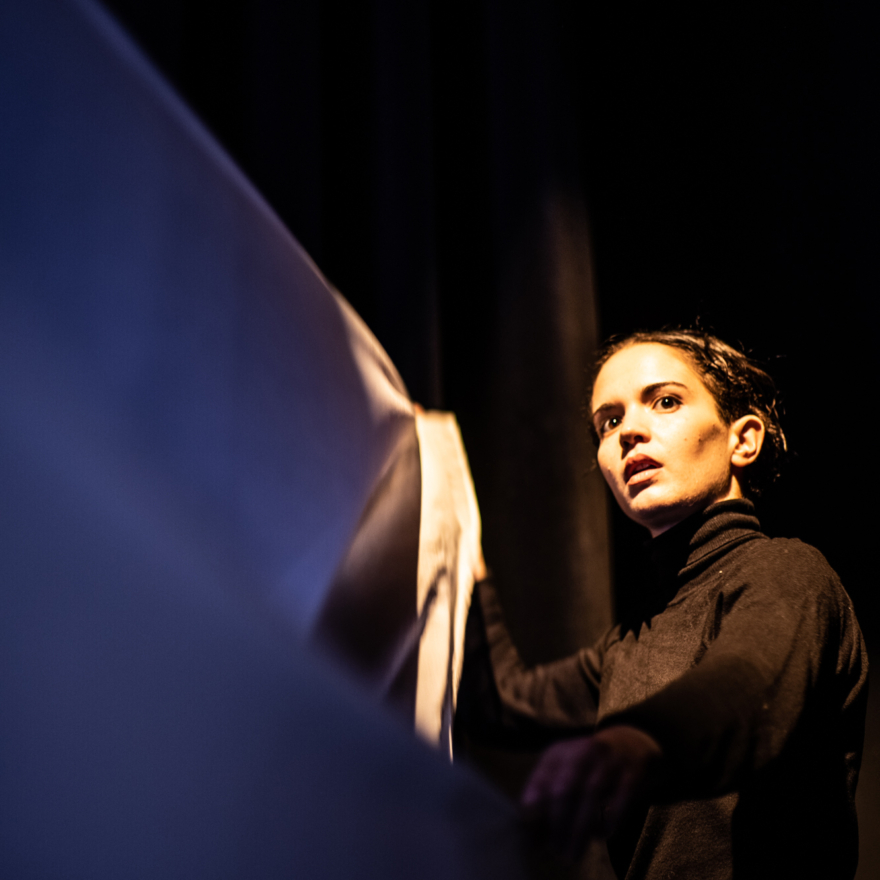A talk with Elena Francalanci,
choreographic development and
performance for “Flow”.
Elena Francalanci is an Italian artist and choreographer who lives in Berlin. She studied classical ballet and began her professional career in dance companies. She performed in many Toihaus performances such as “Im Flatterland”, “Leak” , “Blinds” or “Tilting Moments”. Elena was involved in the development of “Flow” and is also one of the dancers in the alternating cast. In our conversation, we talked about the meaning of “Flow”, the content of the piece, the development and the textiles.
What can the audience expect from the new production?
Elena: A lot of flow.
There’s a strong connection to the materials. As performers, we really get in touch with the different types of fabric. The audience can also expect a lot of movement in connection with the music — that’s a major part of the piece. There’s also the connection between the two dancers themselves. They play a lot with symmetry.
Watching it feels calming, almost like taking a deep breath. It invites the audience to imagine and to create their own stories. The entire piece is abstract and visual, which opens up space for many different images.
What does flow mean to you — the word and the feeling?
Elena: I’ve always considered myself as someone who goes with the flow, not following a long-term plan, but giving myself the chance to be carried and led by whatever comes.
To me, flow is the ability to let go, to follow the path and be led by that flow. It’s not about rational decisions; it comes more from the belly, so it’s very related to emotions.
“Flow” is also an invitation to feel. What does that mean to you, and what can the audience take away from the performance?
Elena: It’s a very somatic experience. There is a lot of touch in the piece — not just with the materials, but also at the end between the performers. There is a moment of clear touch, a picture that everybody can relate to.
For me, it’s very connected to the sense of touch, but also about entering another dimension. You really flow in this space. Since there is no fixed narrative, everyone can find their own interpretation and create their own story.
You were part of the creation process. How was that experience for you?
Elena: It was really interesting, very somatic. We started each day with Feldenkrais, a method based on gentle, mindful movements to enhance body awareness, which allowed us to sink into the floor and get into this tactile, sensory work. Very interesting was noticing how different every person in the cast is — especially because this piece deals so much with duality, connection, and symmetry.
What materials are used in the piece?
Elena: We work with one large piece of white silk, which is extremely light. When you touch it, it responds beautifully to the movement of your arms. Then there’s a paillette fabric, which is very different. You have this super elegant, expensive-looking silk that creates these stunning images, and then the sparkling pailette one, which, when you touch it, doesn’t react in the same way. So we used it differently: Working more with its shape and close to the body.
We also use a very long string with fringes and these ribbons. It’s interesting how these connect in space — there’s always a kind of line between the dancers, the material, and the music.
How are the textile, the music, and the dance connected in the performance?
Elena: To me, they’re always linked by invisible strings. There’s a kind of conversation happening. There are for example three clear Baroque pieces of music, and there’s also a quite choreographed section in the dance. This is connected in kind of a conversation, like we dancers react to the music and the music reacts to the movement.
And what role does each element play on its own? What role play the music and the dance?
Elena: I see it more as a combination of everything. The music provides a rhythm, like a heartbeat, that carries the piece forward. It’s something you can connect to even if you’re not watching. The movement is very visual. This symmetry of the dancers gives to the space a lot of clarity. That gives you the space to really dive in — it creates calm.
What does the production “Flow” mean to you personally?
Elena: It’s emotional. I get emotional every time I watch it.
For me, it’s really about connection and a reminder that we need to reconnect more. There’s this moment at the end where the two dancers are so connected. There is this simplicity of just getting together und with that you become better. It like a sign that we should stop to isolate so much.
For me this piece is a lot about connection. Especially with these strings and ornaments, they are just working together. It’s giving space for each thing to exist and to be peaceful – its beautiful.
